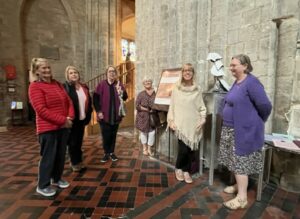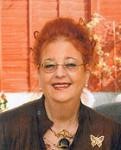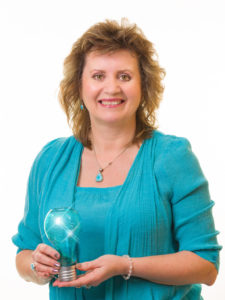SI KING’S LYNN – PROGRAMME
For details of our 2023-2024 club programme please follow the following links:
Programme2023 final 1 Programme 2023 final 2
Speaker meetings
The club has a long history of attracting interesting speakers. Just a few speakers from recent meetings:
- Shakespeare’s Guildhall Trust
- Family History
- King’s Lynn Girls School Trust
- Modern Day Slavery
- Zoom with SI Krakow Please click here for more details
- Celebration and feedback from Belfast Conference
- Scam Awareness and Online Security
Recent highlights…
Margery Kempe: Pious Pilgrim or Pain in the Neck?
In February 2023, a controversial statue was unveiled in King’s Lynn Minster, to commemorate the 650th anniversary of the birth of Margery Kempe, probably the best-known woman in Lynn’s history. The statue has been described as “a melted welly” and our club members wanted to learn more about this lady. We were fortunate to book Susan Maddock, formerly of the County Record Office, and an acknowledged authority on Margery Kempe, to come and speak to us.
So, on June 5, we gathered around the statue in the Minster. Silence reigned as we took it in, and the general atmosphere was one of puzzlement. Then – gradually – we started to talk about it, and view it from different angles, eventually concluding that we could “get” it, didn’t actually dislike it, but didn’t like the sticky-up thingy on the hat. Returning to Marriott’s, we had supper, and learned more about Margery. She was born into a prosperous merchant family in c.1373. Her father, John Brunham, held many official and high-ranking positions in the town, including being mayor five times. Around 1393, Margery married John Kempe, bearing him 14 children, though we do not know how many survived to adulthood, and she died sometime after 1438. She was also the author of the earliest surviving autobiography in English, and regarded as a mystic, a holy woman.
puzzlement. Then – gradually – we started to talk about it, and view it from different angles, eventually concluding that we could “get” it, didn’t actually dislike it, but didn’t like the sticky-up thingy on the hat. Returning to Marriott’s, we had supper, and learned more about Margery. She was born into a prosperous merchant family in c.1373. Her father, John Brunham, held many official and high-ranking positions in the town, including being mayor five times. Around 1393, Margery married John Kempe, bearing him 14 children, though we do not know how many survived to adulthood, and she died sometime after 1438. She was also the author of the earliest surviving autobiography in English, and regarded as a mystic, a holy woman.
After the birth of her first child, she suffered a long illness, now thought to be post-partum depression, which was miraculously cured following her first vision of Christ. Throughout the rest of her life, she had visions – she heard music, saw Christ and the saints, and conversed with them. Her feelings frequently overwhelmed her, as she would break into loud weeping in church, sometimes rolling on the floor in the grip of her emotions. This behaviour attracted much attention, and she was often accused of heresy, but upon examination, successfully defended herself. Make no mistake, she was in real danger: William Sawtrey, a priest at St Margaret’s Church (now King’s Lynn Minster), and a contemporary of Margery, was the first Lollard to be burned for his beliefs. Throughout her life, Margery was a regular visitor to St Margaret’s, where her loud weeping made her unpopular with townsfolk and clergy alike, but she is credited with saving the church from fire in 1421, when she wept and prayed, and a sudden snowstorm put out the fire.
A devout Christian, she made many journeys to holy places. In Norwich, she spent many hours conversing with the Anchoress, Julian of Norwich, and her husband accompanied her on her early journeys outside Norfolk. He was quite sympathetic to her desire to live a holy life, though strenuously objected to her wish for chastity. Eventually, reluctantly, he agreed… Margery went on pilgrimages both in England and abroad, to the Holy Land and to Santiago de Compostela. Her fellow pilgrims found her habit of weeping and wailing loudly at holy sites
something of a trial, and quite often abandoned her, leaving her to make her way back to England as best she could. Her son lived in Danzig (Gdansk), and married a local woman, and they had a daughter. The son and his wife came to Bishop’s Lynn, as it then was, in 1431, leaving the little girl at home. Unfortunately, her son fell ill almost immediately, and died. His widow, who only spoke German, remained in Lynn
until arrangements could be made for her to return home. Margery was to accompany her to Ipswich, where she was to board a ship, but became convinced that God wanted her to go all the way to Danzig with her daughter-in-law. She was around 60 at the time. Disliking sea travel, she decided to return by land as much as possible, getting back to Lynn in about 1434, where she died sometime after 1438.
In creating the statue, the sculptor, Rosemary Goodenough, wanted to represent her as a pilgrim, wearing ragged and patched clothing, and the typical wide-brimmed pilgrim’s hat. Her hands are tucked inside her clothing, so no-one could see that they were shaking with fear when accused of heresy, knowing her terrible fate if found guilty, that of being burned at the stake. Her “topknot” is symbolic of her spirituality and communicating with God. (We all thought it would look better without the horn!) Susan gave us a fascinating and lively talk, and a great insight into the life of a mediaeval woman who is still remembered fondly today.
We were delighted to welcome Dorothy Pulsford-Harris as our speaker. Dorothy is a Barrister specialising in Criminal and Family Law. Dorothy g ave us an enlightened insight into the History of the Middle Temple and the training involved in becoming a barrister and being ‘called’ to the Bar.
ave us an enlightened insight into the History of the Middle Temple and the training involved in becoming a barrister and being ‘called’ to the Bar.
The Middle Temple is one of the four remaining Inns of Court together with, The Inner Temple, Gray’s Inn and Lincoln’s Inn. It is located adjacent to the river Thames between Fleet Street and Victoria Embankment- and is the oldest of the Courts in London. The Temple was established on lands owned by the Knights Templar who were a body of holy men who set up safe routes and funding during the Crusades for peoples on route to the Church of the Holy Scepecre in Jerusalem and subsequently their later headquarters in Acre in the Holy Land during the 11th and 12th century. At that time law was taught in the city of London primarily by the catholic clergy.
After the fall of Jerusalem in 1244, the Knights Influence began to decline and they were finally dissolved in 1312 on Pope Clement V orders. Fortunately, the London based Knights didn’t suffer the same fate as their European counterparts as they were not burnt at the stake ! They did however become tenants of the Earl of Lancaster who owned the The Temple and its lands since 1315. There has subsequently been Lawyers in the temple since 1320 with The Temple later belonging to the Knights Hospitaller of St John – who we know today as St. John Ambulance. The cross of St.George is still part of the arms of Middle Temple today. Henry V111 seized The Temple in 1540 but each Inn contined to hold its share of the Temple for £10pa until James 1 granted it to them jointly in perpetuity in 1608 so long as they continue to provide education and accommodation to lawyers and students and maintain the Chapel Church and its Master. Queen Elizabeth 2nd attended in 2008 and ratified the James 1st charter.
The Middle Temple consists of 43 buildings many are listed. Some date back to the 16th century and others new replacing those damaged over time. The Temple was damaged by the Peasants Revolt of 1381 (when all the records were burnt), a fire in 1679 (which caused more damage than the Great Fire of 1666) and the Blitz between 1940-1944.
Construction of Middle Temple Hall began in 1562 and completed in the early 1570’s its hammerbeam roof is believed to be the best in London. Queen Elizabeth 1st visited the hall in 1578 to inspect the building and it’s the earliest known visit of a reigning monarch to an Inn of Court. It is believed Queen Elizabeth 1st sent wood from her Windsor forest on a boat down the river which formed the high table and the cup board was made from the Golden Hinde of Sir Francis Drake and these are still in situ. There is also a wonderful gardens and fountain in the complex.
The Temple is also connected to Christopher Columbus, Richard 2nd, Geoffrey Chaucer and even King John and the signing of the Magna Carter to name but a few historical events. It is also believed that the first performance of Shakespeare’s Twelfth Night occurred in the hall on 2nd February 1602.
The Inns served as colleges for the education of lawyers until they stopped being responsible for legal education in 1852. Their ethos now is for the training in advocacy and ethics for students, pupil barristers and newly qualified barristers and to provide accommodation and support to new members of the profession.
Training for a barrister takes around 5 years and consists of a 3 year law degree (or an extra year conversion course if a non-law degree is held) followed by a 1 year bar course and 1 year of pupillage and will need to join one of the four Inns of Court. This is followed by regular on-going annual training. A Barrister can undertake any law work although most practice in a specified area. Training consists of mock courts of law, and attending courts with qualified barristers and they do both prosecution and defence training. Originally, trainee barristers had to undertake 24 ‘dinings at the Inns’ before being called to the Bar and would have a sponsor to help them. During the ‘dinings’ the students would listen too and learn from the qualified barristers.
One of the first female barristers the UK was Helena Florence Normanton who was called to the Bar in 1922 and subsequently went onto achieve a number of significant ‘firsts’ in her field. Solicitors were originally’runners’ for Barristers who would search out ‘cases’ in local pubs etc. Barristers are paid fees – not salaries and originally this was via a purse attached to the back of the Barristers robes for clients to put their fees into – the Barrister would not know what fee their clients would pay ! Today fees are negotiated in advance. Solicitors were recognised in their own right following an Act of Parliament in the late 19th century.
Both Solicitors and Barristers can seek to become a King’s Council (KC – formally QC) by applying and having recommendations from Judges and Heads of Chambers. 1000,s apply each year (at a cost of @£5K) but only around 100 are called -,they are then referred to as Silks. Their appointments are based on their proven capabilities, experience and knowledge. The main difference the appointment of a KC brings is that of money as they are able to attract higher fees as take on high net worth and high profile cases. The Lord Chancellor acts as overseer to the appointment system. A fuller history of Middle Temple can be found on their website middletemple.org.uk
Rooting for Earth – Erna Gotyar. To find out more about this amazing eco-friendly, ethical, 100% vegan online store that helps you to live a bit more sustainably click here

Adrienne Greene, a Trainer & Practitioner at The Balance Procedure (TBP) http://www.adriennegreen.co.uk held a very interesting and thought-provoking session, touching on just how powerful our thoughts and feelings can be.
Jane Rose-Land, a Nutritionist with a degree in Nutritional Medicine Jane helps people to better health by supporting them to make changes to their diet and lifestyle. Website for further information: http://www.nutritioninnorfolk.co.uk/
We have taken part in an armchair yoga session with Oli Bell, a local personal trainer and yoga teacher https://www.barefootcrew.com Oli spoke to members about the benefit of yoga as part of a healthy lifestyle before we had an opportunity to have a go ourselves.

